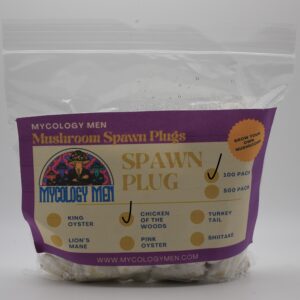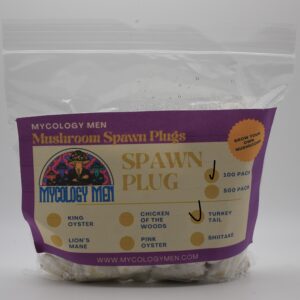Discover the world of mushroom cultivation with our premium Mushroom Spawn Plug. Designed for both amateur and experienced growers, our plugs are the perfect solution for cultivating a variety of delicious and nutritious mushrooms right at home. Made from high-quality materials and inoculated with live mycelium, our Mushroom Spawn Plugs ensure a successful and fruitful growing experience. Whether you’re looking to enhance your garden, create unique culinary dishes, or explore the health benefits of mushrooms, our reliable and easy-to-use spawn plugs are your gateway to a thriving mushroom harvest. Start your mushroom-growing journey today and enjoy the satisfaction of homegrown fungi!
Mushroom cultivation has gained popularity as a rewarding hobby and a sustainable source of food. Our Mushroom Spawn Plugs are specially designed to simplify the growing process, making it accessible to everyone, regardless of their experience level.
Benefits of Using Mushroom Spawn Plugs:
- Ease of Use: Simply insert the plugs into prepared substrates, such as logs or sawdust, and watch as the mycelium colonizes the material. This straightforward method reduces the complexity of traditional growing methods.
- Variety of Mushroom Types: Our Mushroom Spawn Plugs are available for a wide range of mushroom species, including gourmet varieties like Shiitake, Oyster, and Lion's Mane. Each type offers unique flavors and textures, perfect for culinary exploration.
- Sustainable Cultivation: Growing mushrooms at home helps reduce your carbon footprint. By using natural substrates and avoiding commercial farming practices, you contribute to a more sustainable food system.
- Health Benefits: Mushrooms are packed with nutrients, including vitamins, minerals, and antioxidants. Incorporating them into your diet can enhance your overall health and well-being.
- Educational Experience: Cultivating mushrooms can be a fun and educational activity for families and individuals alike. It provides an opportunity to learn about mycology, the science of fungi, and the importance of biodiversity.
How to Get Started with Mushroom Plug Spawn:
To begin your mushroom-growing adventure, all you need is a suitable substrate (like hardwood logs or sawdust), our Mushroom Spawn Plugs, and a bit of patience. After inoculating the substrate with the plugs, maintain the right humidity and temperature, and soon you'll see your mushrooms flourishing.
Join the growing community of mushroom enthusiasts and experience the joy of harvesting your own fresh mushrooms. With our high-quality Mushroom Spawn Plugs, you're well on your way to enjoying a productive and fulfilling cultivation journey!
Choosing the right substrate is crucial for successful mushroom cultivation. Here are some common options:
- Hardwood Logs: Many growers prefer using logs from hardwood trees like oak, maple, or birch to grow mushrooms like Shiitake and Oyster. The logs should be freshly cut and free from any signs of rot.
- Sawdust Blocks: Pre-sterilized sawdust blocks are another popular substrate choice. They are ideal for species like Lion's Mane and Oyster mushrooms and allow for faster colonization.
- Straw: Straw can be used for certain types of mushrooms, such as Oyster mushrooms. It must be pasteurized to eliminate competing organisms.
- Inoculation: This is the process of inserting the Mushroom Spawn Plugs into the substrate. Make sure to space the plugs evenly to ensure proper growth.
- Incubation: After inoculation, place your substrate in a warm, dark area with moderate humidity. During this period, the mycelium will colonize the substrate. This can take a few weeks, depending on the mushroom type and environmental conditions.
- Fruiting Conditions: Once the substrate is fully colonized, it’s time to initiate fruiting. This usually involves exposing the substrate to light, fresh air, and higher humidity. Creating these conditions encourages the mycelium to produce mushrooms.
Harvesting Your Mushrooms
Harvesting is an exciting part of mushroom cultivation. Here are some tips:
- Timing: Mushrooms should be harvested when the caps are still closed or just beginning to open. This ensures maximum freshness and flavor.
- Technique: Use a sharp knife to cut the mushrooms at the base, being careful not to disturb the surrounding mycelium too much. This can help ensure future flushes of mushrooms.
Troubleshooting Common Issues
- Contamination: If you notice unusual colors or smells, it may indicate contamination. Always work in a clean environment and consider using sterile techniques during inoculation.
- Poor Growth: If your mushrooms aren’t growing well, check the temperature, humidity, and light conditions. Adjusting these factors can often resolve growth issues.
- Pests: Keep an eye out for pests like gnats. Using barriers or natural repellents can help protect your growing mushrooms.

